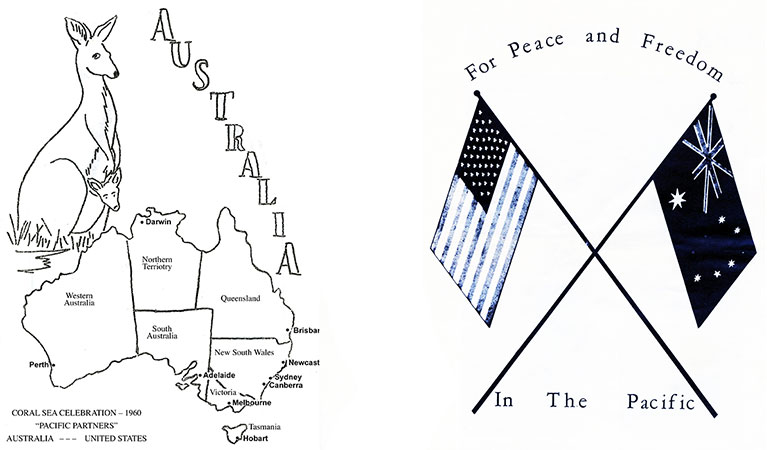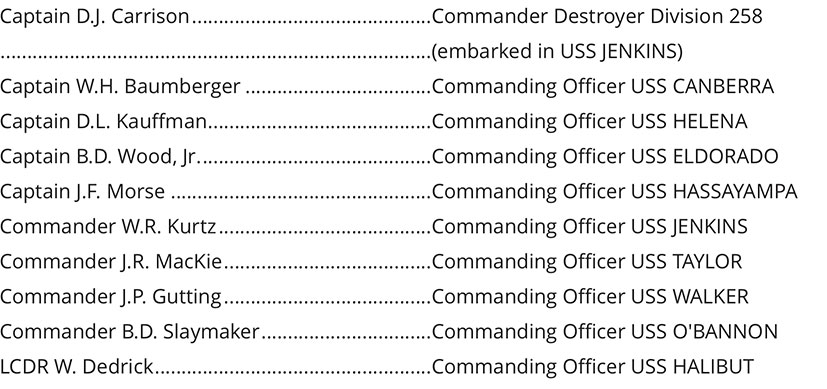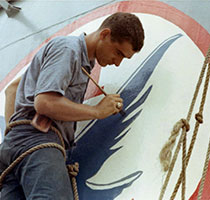Coral Sea Celebration
Headquarters of the Commander in Chief, US Pacific Fleet
HERBERT G. HOPWOOD
Admiral, United States Navy
Pearl Harbor, Hawaii – May 1960
As Commander in Chief, I extend to you a personal greeting and “welcome aboard” this Pacific Fleet ship. It is a great honor to be invited to Australia as your guest during this 18th Coral Sea Celebration, and I hope that your visit aboard will, in a small way, help to repay the hospitality extended to me by the Australian people.
The partnership of Australia and the United States in the preservation of peace and freedom, with honor, in the Pacific is illustrated each year by this meaningful commemoration. We not only celebrate an important victory in the Battle of the Coral Sea, but we underscore our mutual belief that constant vigilance over the Pacific sea lanes is imperative, if we are to protect our free way of life.
In this way a Pacific Partnership, conceived in war, has flowered in peace as an example to the world of how two countries – widely separated geographically – can be close in their programs for a better world. On behalf of all the American people I extend best wishes for a successful Coral Sea celebration.
Battle of the Coral Sea
Recorded in the annals of naval history as one of the most unusual naval engagements of World War II, the Battle of the Coral Sea was fought in May 1942. Prior to this date a confident Japanese Navy was moving into the South Pacific. Its goal was to cut Australia’s lifeline – then isolate the continent for eventual invasion. When a task force of Australian and American ships intercepted the enemy in the Coral Sea on 4 May, this strategic plan was doomed.
The five-day battle that followed was unusual inasmuch as it was the first major battle in which opposing vessels did not see, or even fire a single shot at one another. The battle was one of naval air power. The battle, although a costly one, contained the elements of a great naval victory. As a result of the battle the effectiveness of the Japanese Navy was significantly impaired. This, coupled with stalwart island fighting by units of the Australian Army, removed the immediate threat of a Japanese advance into the South Pacific. As a result of this Coral Sea victory, the allies went on to defeat completely the enemy on 2 September 1945.
Flag Officers
Admiral Herbert G. Hopwood, Commander in Chief of the U.S. Pacific Fleet, is this year’s Coral Sea guest of honor and representative from the United States. In addition to Admiral Hopwood there are three other U.S. Navy flag officers in the area for the Coral Sea celebration. They are:
Rear Admiral John McN. Taylor, Commander Cruiser Division SIX and Commander Cruiser Atlantic, embarked in the USS CANBERRA.
Rear Admiral Frederick J. Becton, Commander Cruiser Division FIVE, embarked in the USS HELENA.
Rear Admiral Charles O. Triebel, Commander Amphibious Group ONE, embarked in the USS ELDORADO.
Where These Nine Ships Came From
The nine ships now visiting Australia to commemorate the 18th anniversary of the Battle of the Coral Sea are presently assigned to the U.S. Seventh Fleet which is continuously deployed in the Western Pacific. Upon completion of their visit, seven of the ships will return to their homeports in the United States. One will continue to operate with the U.S. Seventh Fleet, while another will go on to complete a ‘round-the-world cruise.
Scheduled to return to the United States after visiting Australia are the amphibious command ship ELDORADO, the oiler HASSAYAMPA, the heavy cruiser HELENA and the destroyers WALKER, JENKINS, O’BANNON and TAYLOR. As they sail for their homeports in the United States, other ships will have taken their place in the Western Pacific.
Joining the U.S. Seventh Fleet for duty after visiting Australia will be the nuclear-powered, guided missile-launching submarine HALIBUT and the guided missile cruiser CANBERRA.
The CANBERRA, after operating for a period of time with the U.S. Seventh Fleet, will continue on a ‘round-the-world cruise which will take her through the Suez Canal to temporary duty with the U.S. Sixth Fleet in the Mediterranean. She began her global tour last March on her departure from Norfolk, Virginia. She is scheduled to complete the tour in November.





